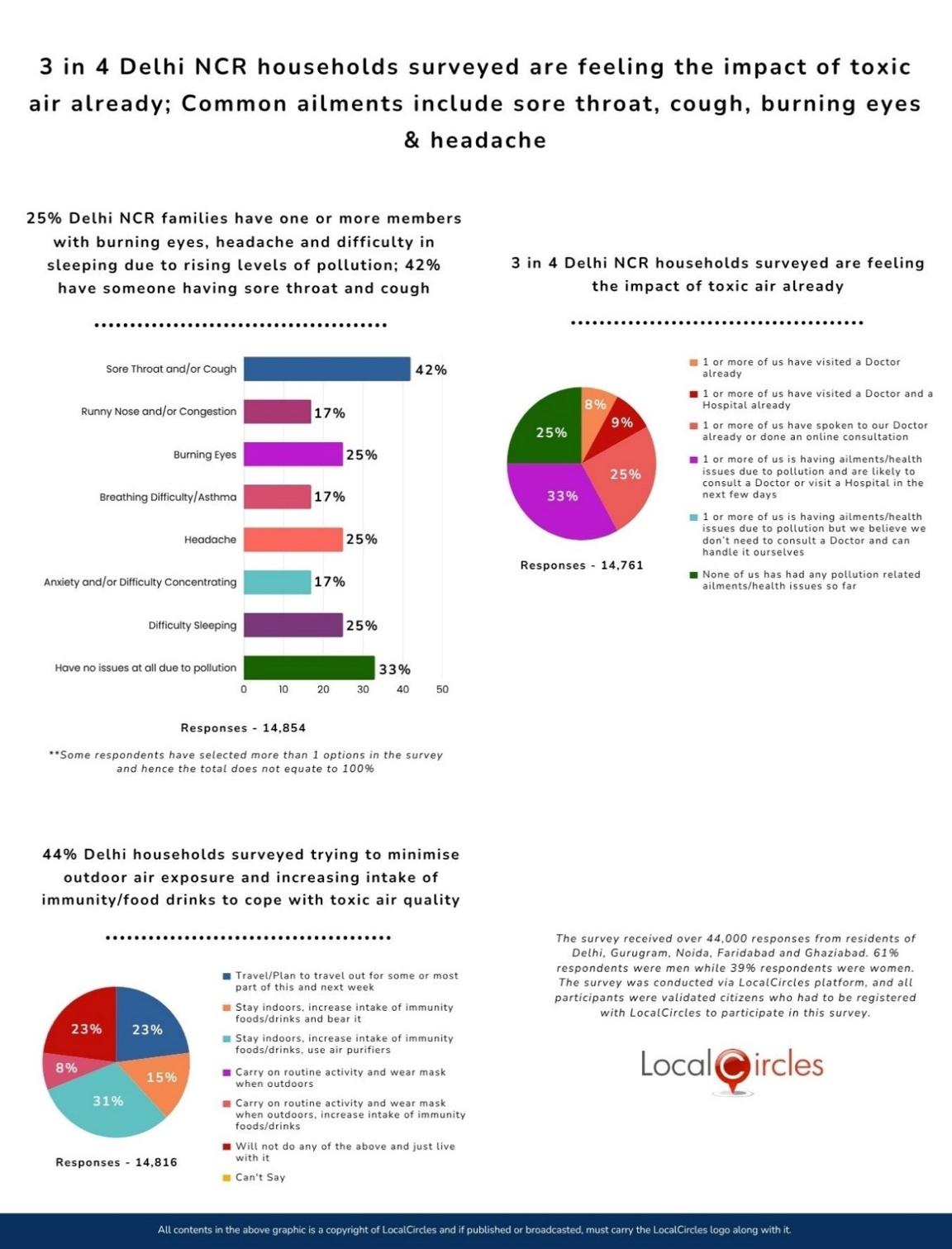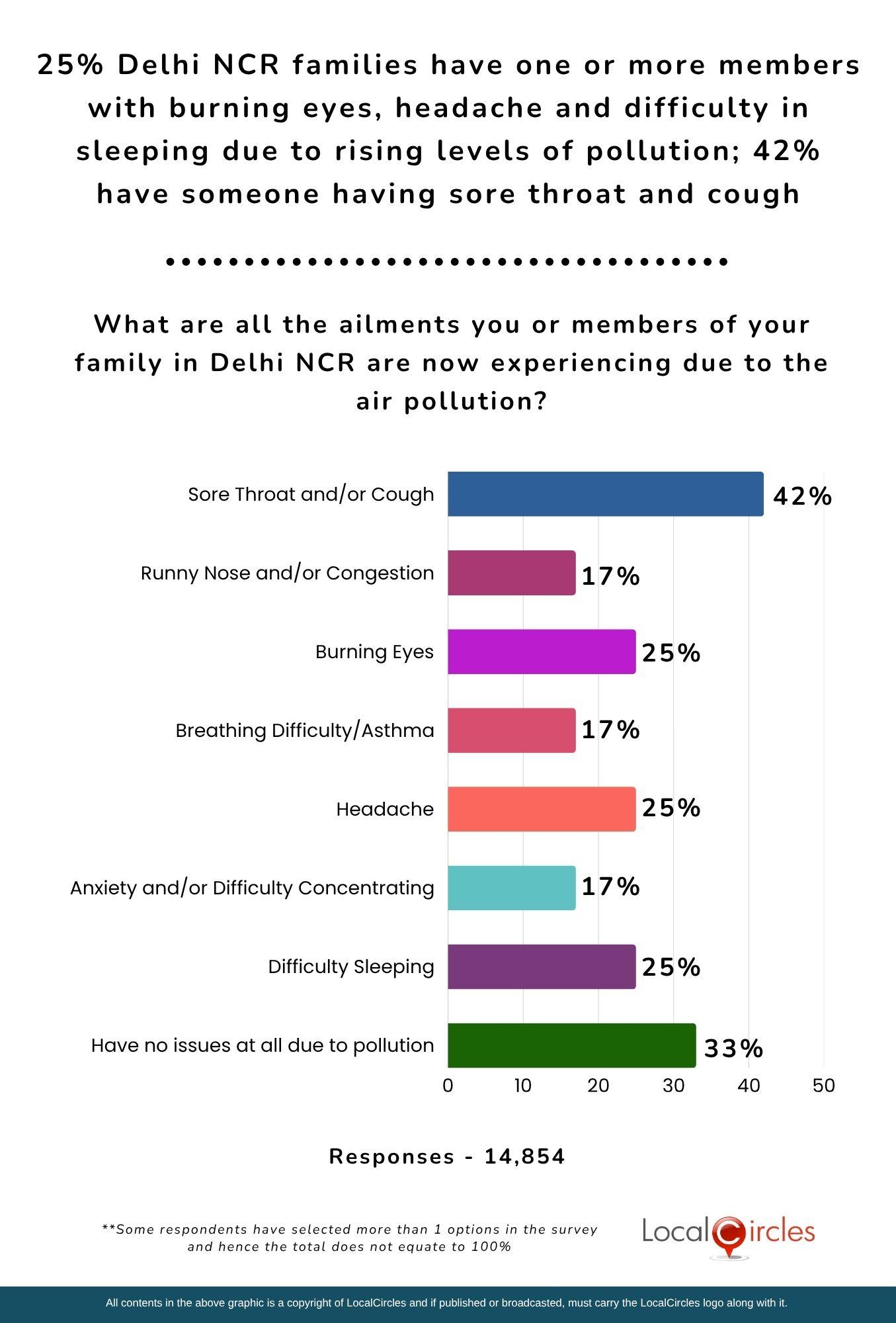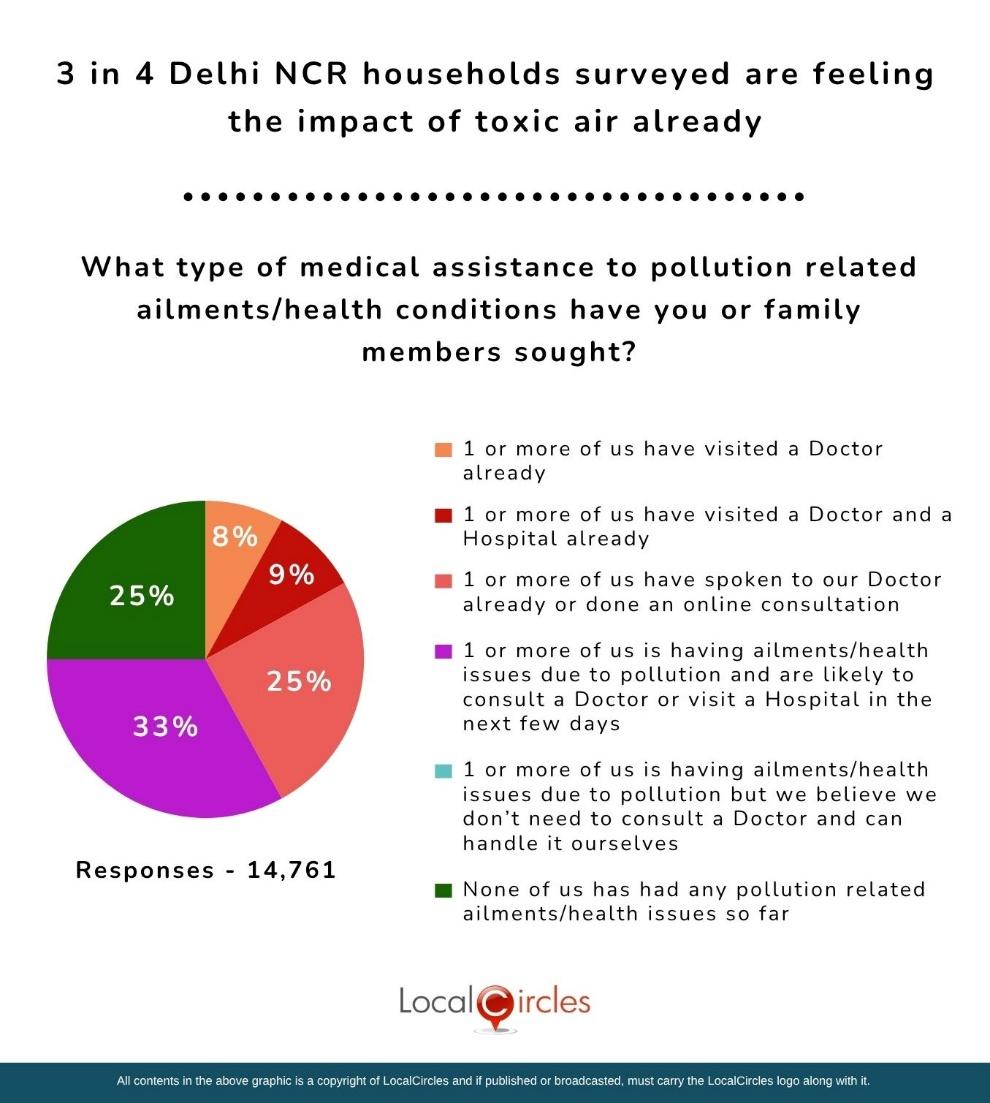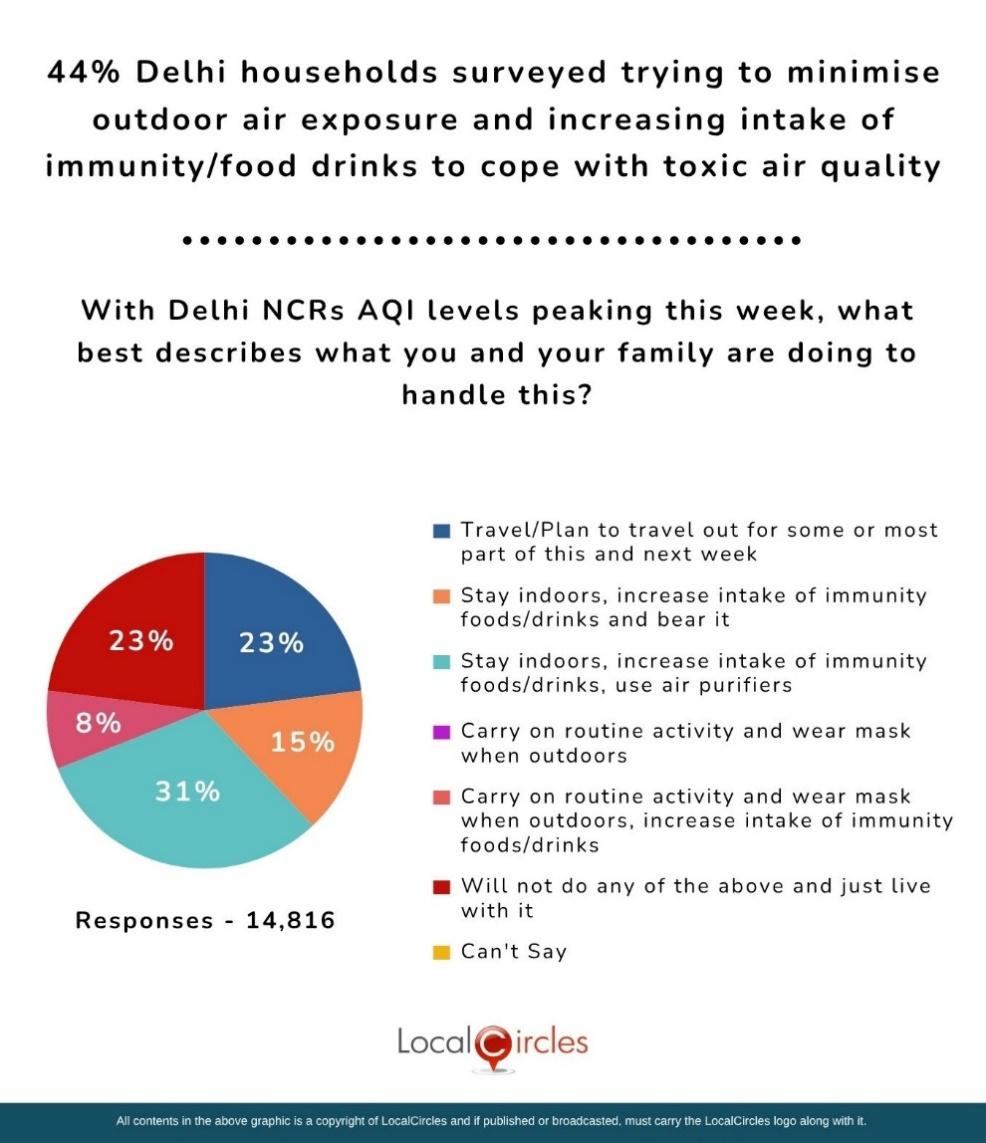3 in 4 Delhi NCR households surveyed are feeling the impact of toxic air already; Common ailments include sore throat, cough, burning eyes & headache
- ● 44% of households surveyed are trying to minimize outdoor air exposure, increasing intake of immunity/food drinks

October 25, 2025, New Delhi: Post Diwali most parts of Delhi NCR saw AQI levels crossing 1000 as many residents lit firecrackers till midnight, despite a Supreme Court directive to use less-polluting green crackers and only during specified times. The Air Quality Index (AQI) in Delhi was 400 across many parts of the city, which is despite reduction in stubble burning in neighbouring states, one of the factors for high air pollution in the national capital in the months of October and November.
Due to massive floods in Punjab and Haryana this year there has been considerable loss of crops, and the harvest too has been delayed. In fact, data shows that there has been 77.5% reduction in total stubble burning events so far this year.
The World Health Organization's guidelines say that exposure to PM 2.5 over a 24-hour-period should be limited to 15 micrograms per cubic metre - but Delhi's AQI in some parts is 24 times higher than the recommended level. The AQI level of PM 2.5 and more directly impact health of people, especially children, pregnant women, the elderly, and those who are unwell, as it can clog lungs and can cause a host of other problems.
In the last several days there is little or no sign of the air quality improving in most part of Delhi NCR. The result is, some residents of Delhi NCR can be seen wearing a face mask to avoid breathing polluted air outdoors. Some have started using air purifiers at home and in the office. Still there is a rise in the number of people who are falling sick due to aggravation of asthma and other health issues.
Through a survey LocalCircles has strived to find out how residents of Delhi NCR are safeguarding against the high levels of air pollution, whether it has resulted in any health issues and what are they doing to cope with their poor health and ailments. The survey received over 44,000 responses from residents of Delhi, Gurugram, Noida, Faridabad and Ghaziabad. 61% respondents were men while 39% respondents were women.
25% of Delhi NCR families have one or more members with burning eyes, headache and difficulty in sleeping due to rising levels of pollution; 42% households surveyed have someone having sore throat and cough
The survey first asked residents of Delhi NCR, “What are all the ailments you or members of your family in Delhi NCR are now experiencing due to the air pollution?” Some among the 14, 854 respondents from Delhi NCR indicated more than one health issue. Out of total, 42% indicated that they or their family members are having “sore throat and/or cough”; 25% of respondents indicated that they are facing “burning eyes”; 25% of respondents indicated “headache”; 25% of respondents indicated “difficulty sleeping”; 17% of respondents indicated " runny nose and/or congestion”; 17% of respondents indicated " breathing difficulty/asthma”; 17% of respondents indicated “anxiety and/or difficulty concentrating”; and 33% of stated that they “have no issues at all due to pollution”. To sum up, 25% of Delhi NCR families have one or more members with burning eyes, headache and difficulty sleeping due to rising levels of pollution; 42% of households surveyed have someone having sore throat and cough.

3 in 4 Delhi NCR households surveyed are feeling the impact of toxic air already
With 24% of households surveyed indicating that one or more family members have been affected by high air pollution, the survey asked, “What type of medical assistance to pollution related ailments/health conditions have you or family members sought?” Out of 14,761 who responded to the question some indicated more than one option with 8% indicating that “1 or more of us have visited a doctor already”; 9% of respondents indicated that “1 or more of us have visited a doctor and a hospital already”; 25% of respondents indicated that “1 or more of us have spoken to our doctor already or done an online consultation”; 33% of respondents indicated that “1 or more of us is having ailments/health issues due to pollution and are likely to consult a doctor or visit a hospital in the next few days”; and 25% of respondents stated that “none of us has had any pollution related ailments/health issues so far”. To sum up, 3 in 4 Delhi NCR households surveyed are feeling the impact of toxic air already.

44% of Delhi households surveyed trying to minimize outdoor air exposure and increasing intake of immunity/food drinks to cope with toxic air quality
As high air pollution is impacting many, the survey next asked, “With Delhi NCRs AQI levels peaking this week, what best describes what you and your family are doing to handle this?” The question received 14,816 responses with 23% stating that they propose to “travel/plan to travel out for some or most part of this and next week”; 15% of respondents indicated that they plan to “stay indoors, increase intake of immunity foods/drinks and bear it”; 31% of respondents indicated that they plan to “stay indoors, increase intake of immunity foods/drinks, use air purifiers”; 8% of respondents indicated that they plan to “carry on routine activity and wear mask when outdoors”; and 23% of respondents stated that they “will not do any of the above and just live with it”. To sum up, 44% Delhi households surveyed trying to minimize outdoor air exposure and increasing intake of immunity/food drinks to cope with toxic air quality.

In summary, 3 in 4 Delhi NCR households or families surveyed are feeling the impact of toxic air already. 25% of Delhi NCR families have one or more members with burning eyes, headache and difficulty in sleeping due to rising levels of pollution. The study revealed 42% of households surveyed have someone having sore throat and cough. 44% of Delhi households surveyed are trying to minimize outdoor air exposure and increasing intake of immunity/food drinks to cope with toxic air quality.
The need of the hour is for various enforcement agencies in the neighbouring state to ensure stubble burning is brought down to zero and for local authorities in Delhi and NCR cities to drive high levels of compliance to GRAP restrictions. In addition, other measures that will minimize pollution levels like usage of anti-smog guns or changing timings of manual sweeping to night times must be deployed on priority.
Survey Demographics
The survey received over 44,000 responses from residents of Delhi, Gurugram, Noida, Faridabad and Ghaziabad. 61% respondents were men while 39% respondents were women. The survey was conducted via LocalCircles platform, and all participants were validated citizens who had to be registered with LocalCircles to participate in this survey.
About LocalCircles
LocalCircles, India’s leading Community Social Media platform enables citizens and small businesses to escalate issues for policy and enforcement interventions and enables Government to make policies that are citizen and small business centric. LocalCircles is also India’s # 1 pollster on issues of governance, public and consumer interest. More about LocalCircles can be found on https://www.localcircles.com
For more queries - media@localcircles.com, +91-8585909866
All content in this report is a copyright of LocalCircles. Any reproduction or redistribution of the graphics or the data therein requires the LocalCircles logo to be carried along with it. In case any violation is observed LocalCircles reserves the right to take legal action.
Enter your email & mobile number and we will send you the instructions.
Note - The email can sometime gets delivered to the spam folder, so the instruction will be send to your mobile as well


